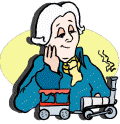BACKGROUND:
An inventor's success
depends upon the conditions and demands of a society as well as the available
technological machines that assist in the development. Technical
advances in one field are usually dependent upon technological progress
in another. For instance, James Watt the inventor of the steam engine,
was in the right society at the right time. In the early 1700's the
Russian Polzunov, and in the 1600's an Italian, Giovani Bianca, designed
a steam turbine. However, they were not in a society where skilled
labor could apply the invention.
 Most scientists work in an
intellectual
framework (paradigm) where they think and produce. When a few scientists
go outside the paradigm or the dogma of the day, it is referred to
as scientific revolution. Scientists, as are most people, are reluctant
to destroy a familiar framework. Sometimes science becomes stale
because of this. Most scientists work in an
intellectual
framework (paradigm) where they think and produce. When a few scientists
go outside the paradigm or the dogma of the day, it is referred to
as scientific revolution. Scientists, as are most people, are reluctant
to destroy a familiar framework. Sometimes science becomes stale
because of this.
Discovery is sometimes hampered
by too much structure in science. The "scientific method" of Francis
Bacon in the 17th century of experimentation, observation, and generalization
is really not how science works. By the mid-20th century people realized
there was no one scientific method, but many different methods applicable
to different sciences and to different problems within them.
Creativity of observations and
searching for answers where no one looks is key to excitement in science.
Science is interdisciplinary
with far reaching conclusions. Science is many things to many people.
Looking at science from a historical perspective, notice that most of the
modern technology has been "discovered" within the last 100 years, one
discovery leads to another. The next few labs will focus on the need
for some inventions and how technology has changed our lives.
PROCEDURE:
- Instruct students to do a library or internet search on a scientific breakthrough that interests
them. Use books like the recommended Inventions to help students
focus on one invention..
- Students should be instructed to write
a short essay on "A Technology that changed the World." Use the enclosed
sheet to help guide students. Students should draw their technology
in the box. Topics for students to research include telephone, cinema,
car, light bulb, bicycle, or any other technology.
|